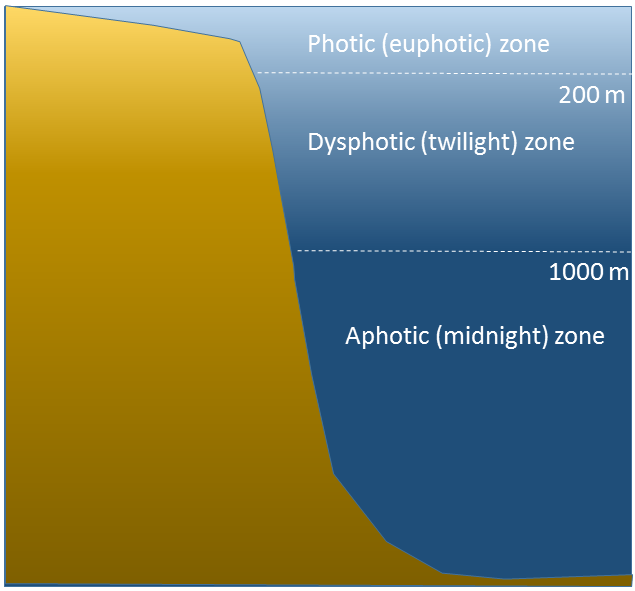4. Sound and Light
Sound
Sound is a form of energy transmitted through pressure waves. With ocean sounds, the energy is transmitted via water molecules vibrating back and forth parallel to the direction of the sound wave, and passing on the energy to adjacent molecules. Therefore, sound travels faster and more efficiently when the molecules are closer together and are better able to transfer their energy to neighboring particles. In other words, sound travels faster through denser materials. Since water is much denser than air, the speed of sound in water (about 1500 m/s) is approximately five times faster than the speed in air (around 330 m/s). This helps explain why we sometimes have difficulty localizing the source of a sound that we hear underwater. We localize sound sources when our brains detect the tiny differences in the time of arrival of sounds reaching our ears. A sound coming from our left will reach our left ear a fraction of a second before reaching our right ear. Our brains can process that small difference in time of arrival to recognize the direction from which the sound came. In water, the sound is so much faster that the difference in arrival time between our ears becomes too small for us to interpret, and we lose the ability to localize the source.
However, as with sound in air, the speed of sound in the ocean is not constant; it is influenced by a number of variables including temperature, salinity, and pressure, and an increase in any of these factors will lead to an increase in the speed of sound. We have seen that these variables change with depth and location; so to will the speed of sound differ in different regions of the ocean.
To examine the way the speed of sound changes as a function of depth, we need to consider the vertical profiles for temperature and pressure. At the surface, the pressure is low, but the temperature is at its highest point in the water column. The temperature effects dominate at the surface, so the speed of sound is fast in surface waters. As depth increases, the temperature and the speed of sound decline. Near the bottom, the extreme pressure dominates, and even though temperatures are low, the speed of sound increases with depth. At moderate depths (between a few hundred and one thousand meters) there is a zone where both temperature and pressure are relatively low, so the speed of sound is at a minimum. This zone of minimum speed is called the SOFAR channel (Sound Fixing And Ranging) or the Deep Sound Channel (Figure 4.4.1).
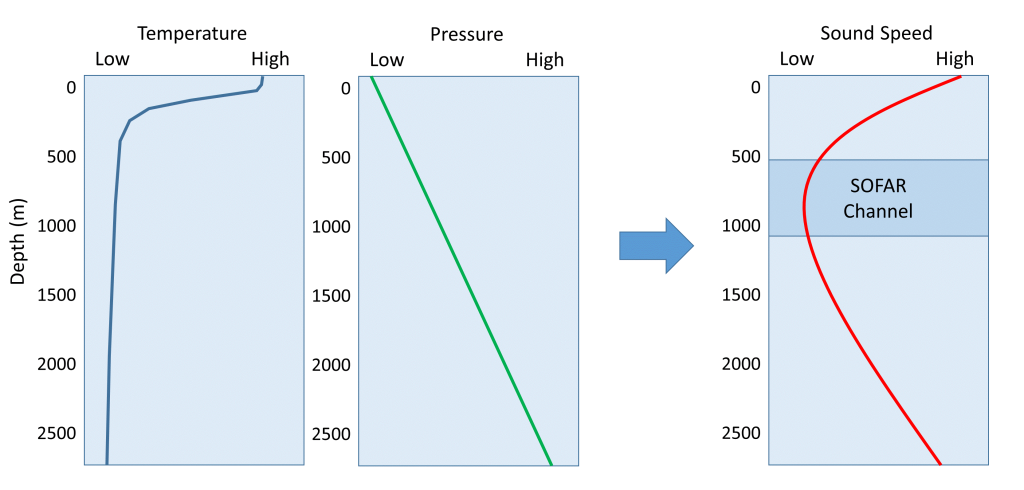
The SOFAR channel is important because sounds produced in that region can be propagated over very long distances with little attenuation (loss of energy). Sound waves produced in the channel radiate out in all directions. Waves that travel into shallower or deeper water outside of the sound channel are entering a region of faster sound transmission. As we saw with seismic waves, when these sound waves encounter a region of differing transmission speed, the waves tend to be refracted or bent back towards the region of lower speed. As a result, sound waves moving from the SOFAR channel into shallower water will be refracted back towards the channel. As the sound waves go deeper below the channel, they will be refracted upwards, back into the channel and the region of slower speed. In this way, much of the sound does not dissipate out into the water in all directions, but instead is trapped within the channel, and can travel very long distances with little loss of energy (Figure 4.4.2).
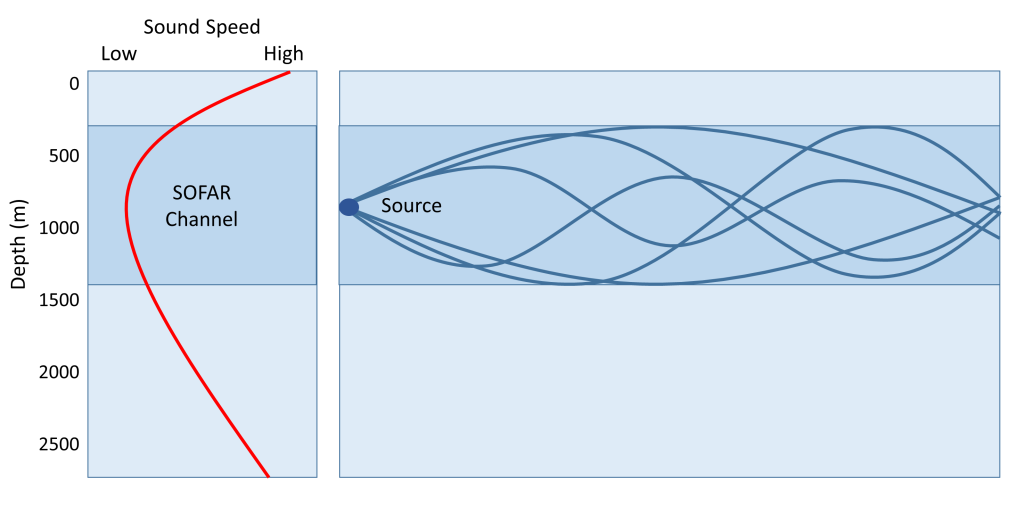
There are several practical applications of the SOFAR channel. Baleen whales are thought to use the SOFAR channel to communicate with each other over long distances of hundreds to thousands of kilometers. Their vocalizations are very loud and are low frequency calls, which travel farther than high frequency sounds in the oceans. The military has been able to track submarines using the SOFAR channel, and during World War II it was used to locate downed pilots or missing ships and planes. A stranded pilot could drop a small device into the water, and once it sank into the SOFAR channel it would explode, creating a sound that could be heard at multiple listening stations. Using the time of arrival of the sound at the various receivers, the location of the source could be determined through triangulation. In the 1990s it was suggested that the SOFAR channel could be used to monitor global ocean temperatures. A project known as ATOC (Acoustic Thermometry of Ocean Climate) was proposed where loud, low frequency sounds produced near Hawaii and California would travel through the SOFAR channel to receiving stations around the Pacific. By monitoring the time it took for the sounds to reach the receivers, scientists could monitor changes in ocean temperatures on a global scale, as sounds would move faster through a warming ocean.
Since sound travels better through water than air, the energy required to transmit a given sound wave is higher in air than in water. The energy, or intensity (loudness) of a sound is measured on the decibel (dB) scale. It turns out that it takes about 61 times more energy to transmit a sound through air than through water. Because of this energy difference, there is a 61 dB difference between sounds transmitted through air and water, such that a sound intensity of 120 dB in water would be equivalent to an intensity of about 60 dB in air. This should be kept in mind when trying to compare sounds in the ocean with sounds in the air. A sound of 130 dB in air is about equivalent to standing 100 m from a jet engine at takeoff. A sound of 130 dB in water is equivalent to about 70 dB in air, which is the intensity of the sound of a vacuum cleaner. It should also be pointed out that on the dB scale, an increase of 10 dB means the sound is 10 times louder. In other words, 20 dB is 10 x louder than 10 dB, while 30 dB is 100 x louder than 10 dB.
- Discovery of Sound in the Sea website: http://www.dosits.org/
Light
Radiant energy from the sun is important for several major oceanic processes:
- Climate, winds, and major ocean currents are ultimately dependent on solar radiation reaching the Earth and heating different areas to different degrees.
- Sunlight warms the surface water where much oceanic life lives.
- Solar radiation provides light for photosynthesis, which supports the entire ocean ecosystem.
The energy reaching Earth from the sun is a form of electromagnetic radiation, which is represented by the electromagnetic spectrum (Figure 4.4.3). Electromagnetic waves vary in their frequency and wavelength. High frequency waves have very short wavelengths, and are very high energy forms of radiation, such as gamma rays and x-rays. These rays can easily penetrate the bodies of living organisms and interfere with individual atoms and molecules. At the other end of the spectrum are low energy, long wavelength waves such as radio waves, which do not pose a hazard to living organisms.
Most of the solar energy reaching the Earth is in the range of visible light, with wavelengths between about 400-700 nm. Each color of visible light has a unique wavelength, and together they make up white light. The shortest wavelengths are on the violet and ultraviolet end of the spectrum, while the longest wavelengths are at the red and infrared end. In between, the colors of the visible spectrum comprise the familiar “ROYGBIV”; red, orange, yellow, green, blue, indigo, and violet.
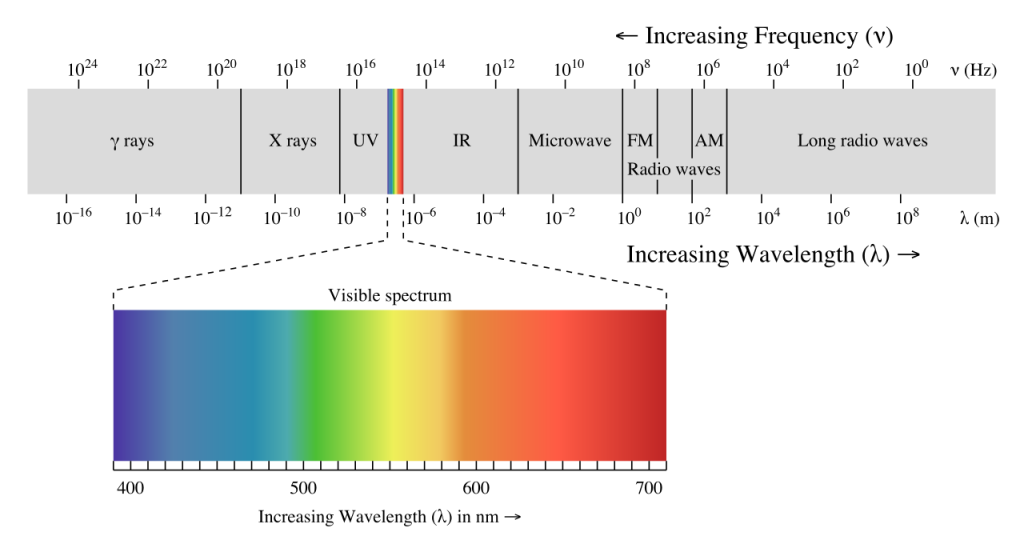
Water is very effective at absorbing incoming light, so the amount of light penetrating the ocean declines rapidly (is attenuated) with depth (Figure 4.4.4). At 1 m depth, only 45% of the solar energy that falls on the ocean surface remains. At 10 m depth only 16% of the light is still present, and only 1% of the original light is left at 100 m. No light penetrates beyond 1000 m.
In addition to overall attenuation, the oceans absorb the different wavelengths of light at different rates (Figure 4.4.4). The wavelengths at the extreme ends of the visible spectrum are attenuated faster than those wavelengths in the middle. Longer wavelengths are absorbed first; red is absorbed in the upper 10 m, orange by about 40 m, and yellow disappears before 100 m. Shorter wavelengths penetrate further, with blue and green light reaching the deepest depths.
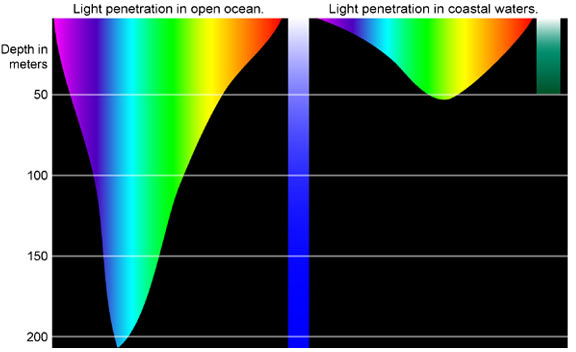
This explains why everything appears blue under water. The colors we perceive depends on the wavelengths of light that are received by our eyes. If an object appears red to us, that is because the object reflects red light but absorbs all of the other colors. So the only color reaching our eyes is red. Under water, blue is the only color of light still available at depth, so that is the only color that can be reflected back to our eyes, and everything has a blue tinge under water. A red object at depth will not appear red to us because there is no red light available to reflect off of the object. Objects in water will only appear as their real colors near the surface where all wavelengths of light are still available, or if the other wavelengths of light are provided artificially, such as by illuminating the object with a dive light.
Water in the open ocean appears clear and blue because it contains much less particulate matter, such as phytoplankton or other suspended particles, and the clearer the water, the deeper the light penetration. Blue light penetrates deeply and is scattered by the water molecules, while all other colors are absorbed; thus the water appears blue. On the other hand, coastal water often appears greenish. Coastal water contains much more suspended silt and algae and microscopic organisms than the open ocean. Many of these organisms, such as phytoplankton, absorb light in the blue and red range through their photosynthetic pigments, leaving green as the dominant wavelength of reflected light. Therefore the higher the phytoplankton concentration in water, the greener it appears. Small silt particles may also absorb blue light, further shifting the color of water away from blue when there are high concentrations of suspended particles.
The ocean can be divided into depth layers depending on the amount of light penetration. The upper 200 m is referred to as the photic or euphotic zone. This represents the region where enough light can penetrate to support photosynthesis, and it corresponds to the epipelagic zone. From 200-1000 m lies the dysphotic zone, or the twilight zone (corresponding with the mesopelagic zone). There is still some light at these depths, but not enough to support photosynthesis. Below 1000 m is the aphotic (or midnight) zone, where no light penetrates. This region includes the majority of the ocean volume, which exists in complete darkness.
